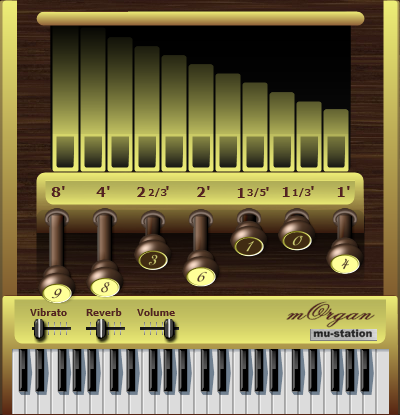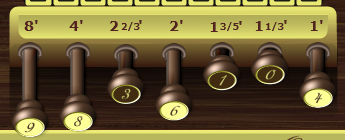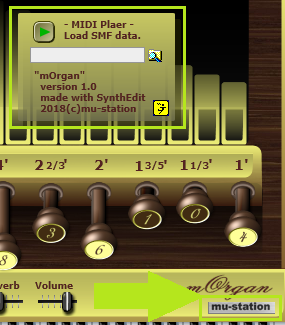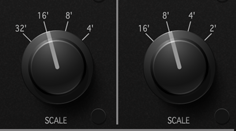
|
「mOrgan」(※モーガンと読みます)は、パイプオルガンの発音の仕組みを参考に、その原理そのものをソフトウエア上に再現したモデリング音源プラグインです。
パイプオルガンは、固有の音階を持った無数のパイプを配置し、鍵盤操作でそれら一本一本に空気を送り込むことで発音しますが、その際に一つの鍵盤につき、最大同時に7本のパイプを発音した状態を、このプラグインでは再現しています(一般的なパイプオルガンでは、さらに低音が2本加わります)。
音色の調整は、「ストップ」と呼ばれるレバーを引っ張ることで音量を調整し、その7本のストップのバランスで、柔らかい音から尖った音など、多彩な音色を作ることができます。
低音部を省略しているために音色の特徴としては全般的には軽めで、小さなチャペルに設置されたパイプオルガンをイメージしています。
鍵盤を弾く強弱では、音量を変えるためのベロシティとは異なり、実際のパイプオルガンと同じく、空気が送り込まれて発音するまでの微妙なタイミングを調整する仕掛けとしているため、強弱によっても音色が変わります。
それぞれの音色には、より自然なパイプオルガンの音色に近づけるため、かすかに空気が通る環境ノイズや音の揺らぎ、そして壁の反響によって起きる低音域の反射音を発音させ、チャペルの残響を表現する奥行と立体感を表現可能な、特殊なリバーブも搭載しています。
モジュレーションホイールは、電気モーターで動作するビブラートを発生する装置(いわゆるロータリースピーカー)をコントロールして、音の揺らぎと残響を加えることができるようになっています。
実は、先にリリースした無限音階オルガン「mu-GEN」は、このパイプオルガン「mOrgan」を作っている間に、ふと思い立って横道に逸れて派生して作り始め、先に完成してしまったプラグインで、本来のオルガン音源制作のための研究はこちらにかけた時間が長く、ずっと先に着手していました。
二つのオルガンは内部的な発音方式は似ていますが、それぞれのパイプを想定した音源を調整するやり方の違いで、全く異なる特徴のオルガンに仕上がっています。
また、mu-GENで搭載したMIDIプレイヤー機能も搭載していますので、バッハなど古典クラシックのスタンダードMIDIファイルデータを読み込んで再生すれば、臨場感あるチャペルのパイプオルガンの音色を堪能できます。
"MOrgan" (Read as Morgan) is a modeling sound plug-in that reproduces the principle itself on software with reference to the structure of the pronunciation of the pipe organ.
The pipe organ plays countless pipes with its own scale and sound while sending air one by one with the keyboard operation, but at that time up to seven pipes are reproduced at the same time for each key with this plug-in Two more bases have been added in the pipe organ).
To adjust the tone, pull the lever called "stop" to adjust the volume. With a balance of 7 stops, you can create a variety of sounds from soft to sharp sounds.
Since the bass part has been omitted, it is generally bright as a feature of the tone and expresses the pipe organ installed in the small chapel.
Unlike the actual pipe organ, the strength of playing the keyboard is different from the speed of changing the volume, it is a mechanism to adjust subtle timing until sending air, so the sound changes depending on strength.
In order to bring each tone closer to the sound of a more natural pipe organ, the environmental sounds and sound fluctuations that slightly pass through the air, as well as the bass reflections caused by wall echoes are sounded. A special reverb that can express the depth and the three-dimensional effect expressing the reverberation of the chapel is also carried.
The modulation wheel can control devices (so-called rotary speakers) that generate vibrato that operates with electric motors, and can add sound fluctuations and reverberation.
Actually, "mu-GEN" completed before this pipe organ departed from this organ and started making it. The time spent here was long, and it began long ago.
The two organs are similar in internal pronunciation method, but the way to adjust the sound source assuming each pipe is different, and the organ with completely different characteristics is finished.
Also, since the MIDI player function attached to mu-GEN is also installed, if you read and play the standard MIDI file data of Bach and other classical songs, you can enjoy the sound of pipe organ of real chapel .


